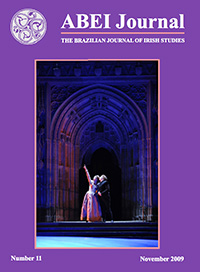Childhoods in Irish Writing
DOI:
https://doi.org/10.37389/abei.v11i0.3651Keywords:
Childhood, Irish Writing, Irish writers.Abstract
Childhood is a crucial stage of Irish life. It is the time in which essentials of Irish experience are nurtured, which will be developed later in a
broader scope. Childhood is depicted as a universally important theme in all Irish writing, regardless of its artistic orientation towards traditional or countertraditional. In traditional writing, childhood is depicted in the interactions between people and society. Protagonists are glimpsed actively living in realistic surroundings, among lively people. On the other hand, in counter-traditional writing, which is an artistically created universe, reality is replaced by fictiveness. Over an author’s body of work there may be fixity and recurrence in protagonists and themes, to elucidate life’s structure in a whole artistic perspective. Regardless
of orientation, Irish writing invariably has influential roots in childhood, because childhood is where Irishness gains its essential foothold. This paper spotlights and elucidates childhood, investigating how it works as an influential element in forming protagonists in linkage with later life.


